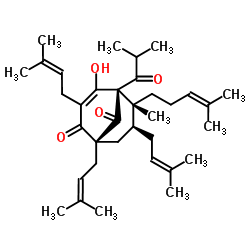Hyperforin

Hyperforin structure
|
Common Name | Hyperforin | ||
|---|---|---|---|---|
| CAS Number | 11079-53-1 | Molecular Weight | 536.785 | |
| Density | 1.0±0.1 g/cm3 | Boiling Point | 616.8±55.0 °C at 760 mmHg | |
| Molecular Formula | C35H52O4 | Melting Point | 79-80ºC | |
| MSDS | USA | Flash Point | 340.9±28.0 °C | |
| Symbol |



GHS02, GHS06, GHS08 |
Signal Word | Danger | |
|
Plant flavonol isorhamnetin attenuates chemically induced inflammatory bowel disease via a PXR-dependent pathway.
J. Nutr. Biochem. 25(9) , 923-33, (2014) Isorhamnetin is an O-methylated flavonol present in fruit and vegetables. We recently reported the identification of isorhamnetin as an activator of the human pregnane X receptor (PXR), a known target for abrogating inflammation in inflammatory bowel disease ... |
|
|
Phytochemical analysis and in vitro biological activity of three Hypericum species from the Canary Islands (Hypericum reflexum, Hypericum canariense and Hypericum grandifolium).
Fitoterapia 100 , 95-109, (2015) In the present work we carried out a phytochemical and biological investigation on three Hypericum species, i.e. Hypericum reflexum, Hypericum canariense and Hypericum grandifolium, from the Canary Islands where they are traditionally used as diuretic, wound ... |
|
|
Human UGT1A4 and UGT1A3 conjugate 25-hydroxyvitamin D3: metabolite structure, kinetics, inducibility, and interindividual variability.
Endocrinology 155(6) , 2052-63, (2014) 25-Hydroxyvitamin D3 (25OHD3) is used as a clinical biomarker for assessment of vitamin D status. Blood levels of 25OHD3 represent a balance between its formation rate and clearance by several oxidative and conjugative processes. In the present study, the ide... |
|
|
Improved assays for xenosensor activation based on reverse transfection.
Toxicol. In Vitro 29 , 1759-65, (2015) Discovery of receptor-dependent mechanisms for regulation of drug metabolism has provided a new way to evaluate the propensity of drug candidates to cause induction of cytochrome P450 enzymes. Therefore, receptor-based reporter assays have become common in ea... |
|
|
Mechanosensitive ATP release from hemichannels and Ca²⁺ influx through TRPC6 accelerate wound closure in keratinocytes.
J. Cell Sci. 127(Pt 19) , 4159-71, (2014) The study aimed to investigate the effect of inhibition of poly(ADP-ribose) polymerase-1 (PARP-1) activity on tau phosphorylation in HEK293/tau441 cells and its mechanism. HEK293/tau441 cells were treated with 3-aminobenzamide (3-AB), a PARP-1 inhibitor, at d... |
|
|
Hypericum perforatum: pharmacokinetic, mechanism of action, tolerability, and clinical drug-drug interactions.
Phytother Res. 28(5) , 643-55, (2014) Hypericum perforatum (HP) belongs to the Hypericaceae family and is one of the oldest used and most extensively investigated medicinal herbs. The medicinal form comprises the leaves and flowering tops of which the primary ingredients of interest are naphthodi... |
|
|
In vitro photochemical and phototoxicological characterization of major constituents in St. John's Wort (Hypericum perforatum) extracts.
Phytochemistry 72(14-15) , 1814-20, (2011) Extracts from St. John's Wort (SJW: Hypericum perforatum) have been used for the treatment of mild-to-moderate depression. In spite of the high therapeutic potential, orally administered SJW sometimes causes phototoxic skin responses. As such, the present stu... |
|
|
Effects of UV-B on secondary metabolites of St. John's Wort (Hypericum perforatum L.) grown in controlled environments.
Photochem. Photobiol. 87(3) , 680-4, (2011) The medicinal plant industry is under increasing scrutiny due to wide variance in active ingredient (AI) concentration from values claimed on labels. Reasons for this disparity include environmental and genotypic variation which influence AI concentration. St... |
|
|
Investigating the effectiveness of St John's wort herb as an antimicrobial agent against mycobacteria.
Phytother Res. 26(9) , 1327-33, (2012) A persistent need exists for effective treatment agents for mycobacterial infections. This research investigated the effectiveness of the Hypericum perforatum herb (commonly known as St John's wort; SJW) in its growth inhibition of mycobacteria. A SJW extract... |
|
|
Secondary metabolites of Hypericum leptophyllum Hochst., an endemic Turkish species.
ScientificWorldJournal 2012 , 501027, (2012) In the present study, the presence of the phloroglucinol derivative hyperforin, the naphthodianthrones hypericin and pseudohypericin, the phenylpropane chlorogenic acid and the flavonoids rutin, hyperoside, kaempferol, isoquercetine, quercitrine, and querceti... |